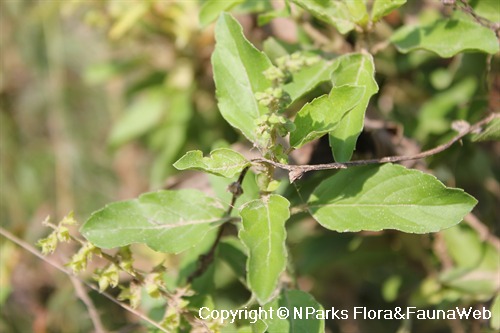
Back
Ocimum americanum
| Family Name: | Lamiaceae (Labiatae) |
| Common Name: | Lime Basil, American Basil, Hoary Basil, 灰罗勒 |
Name
Classifications and Characteristics
| Plant Division | Angiosperms (Flowering Seed Plants) (Dicotyledon) |
|---|---|
| Plant Growth Form | Herbaceous Plant |
| Lifespan (in Singapore) | Perennial |
| Mode of Nutrition | Autotrophic |
| Maximum Height | 0.5 m |
Biogeography
| Native Distribution | Africa, China, Indian Subcontinent, Indo-China, Malesia |
|---|---|
| Native Habitat | Terrestrial |
| Preferred Climate Zone | Tropical, Sub-Tropical / Monsoonal |
Description and Ethnobotany
| Growth Form | Small herbaceous plant with erect growth habit. |
|---|---|
| Foliage | Gland-dotted on both surface. |
| Stems | Stem and branched quadrangular, yellowish green, densely white-pilose in young plant. |
| Flowers | Small, white to light blue flowers (1 cm long) are composed of an upper and lower lip, the lower lip being slightly larger. White stamens are slightly longer than the lower lip. Terminal inflorescence is composed of flowers in whorled arrangement. The flowers are similar to that of Ocimum basilicum, but the upper lip of the calyx is shorter (2 - 3 mm long compared to 4 - 6 mm long). The inside of the calyx is also densely hairy above the fruits. |
| Fruit | Small, 1-seeded fruits are known as nutlets. In water the nutlet-wall produces a thick white cover of slimy threads within several minutes. |
| Habitat | Often found in tropical climates, growing on roadsides, in fields, in teak forests, and in open waste place close to settlements. |
| Ethnobotanical Uses | Edible Plant Parts : Edible Leaves Food (Fruit or Vegetable): Compared to sweet basil (O. basilicum) shrubby basil (O. gratissimum) and holy basil (O. tenuiflorum), which are very fragrant, O. americanum is mild in flavor. It is cultivated for the young leaves, which are eaten raw as a vegetable side-dish in Indonesia, Malaysia and Thailand. (Herb or Spice): The fragrant leaves are also added to various dishes with fishy or disagreeable smell. Medicinal: In traditional medicine, hoary basil is used for several ailments. Decoctions are used for coughs, pounded leaves are used for respiratory problems, the whole plant is used in baths to treat rheumatism, renal colic and calcification. Others: The essential oil of the plant is used in soap and cosmetics. |
Landscaping Features
| Landscape Uses | General, Parks & Gardens, Container Planting |
|---|---|
| Thematic Landscaping | Economic Garden |
Plant Care and Propagation
| Light Preference | Full Sun |
|---|---|
| Water Preference | Moderate Water |
| Plant Growth Rate | Slow |
| Diseases | No serious diseases and pets have been reported. |
| Propagation Method | Seed |
Foliar
| Foliage Retention | Evergreen |
|---|---|
| Mature Foliage Colour(s) | Green |
| Mature Foliage Texture(s) | Smooth |
| Foliar Type | Simple / Unifoliate |
| Foliar Arrangement Along Stem | Opposite |
| Foliar Attachment to Stem | Petiolate |
| Foliar Shape(s) | Non-Palm Foliage (Lanceolate, Elliptical) |
| Foliar Margin | Entire |
| Foliar Base | Acute, Cuneate |
Floral (Angiosperm)
| Flower Colour(s) | Blue, White |
|---|---|
| Flower Grouping | Cluster / Inflorescence |
| Flower Location | Terminal |
Image Repository
Others
| Master ID | 30737 |
|---|---|
| Species ID | 5057 |
| Flora Disclaimer | The information in this website has been compiled from reliable sources, such as reference works on medicinal plants. It is not a substitute for medical advice or treatment and NParks does not purport to provide any medical advice. Readers should always consult his/her physician before using or consuming a plant for medicinal purposes. |





